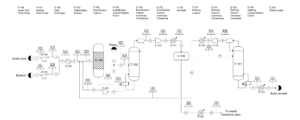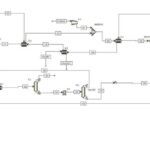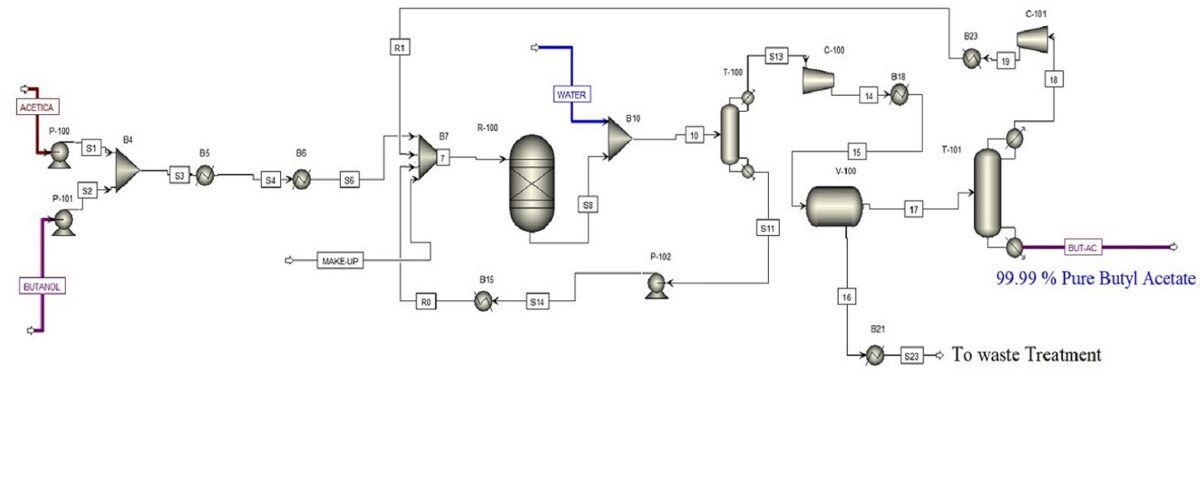Introduction
Butyl acetate, a colorless liquid with a fruity smell, is used as a solvent, diluent, flavoring agent and in the pharmaceutical and cosmetic industries. The production of this valuable compound is done through the esterification reaction of butyric acid and ethanol. Aspen Plus simulation provides an efficient way to model and analyze this complex process, with the aim of improving the efficiency and quality of the final product.
Butyl acetate, an organic compound with many applications in various industries, is produced through a process involving the esterification of butyric acid and ethanol. Aspen Plus simulation as a powerful tool helps chemical engineers in modeling and optimizing this process. Butyl acetate is an organic compound with the formula CH3COOC4H9. which is used as a solvent in various industries such as food, pharmaceutical, cosmetics and resin industries.
The Description of The Production Process of Butyl Acetate Includes The Following Steps:
Raw Material Pumping:
In the Aspen Plus simulation of the butyl acetate production process, raw material pumping plays an essential role in transferring the material to the reactor and starting the esterification reaction. Acetic acid is pumped into the process from the P-100 tank with the Feed Pump.
Butanol is pumped from the P-101 tank into the process with the Feed Pump. By accurately simulating the pumping of raw materials in Aspen Plus, it is possible to correctly predict the actual performance of the butyl acetate production process and make the necessary optimizations to improve efficiency and reduce energy consumption.
Heat Exchanger:
This section is responsible for heat exchange between different flows. This heat exchange is necessary to control the temperature and maintain the reaction conditions within the desired range. Choosing the right type of heat exchanger depends on factors such as It depends on the required heat exchange capacity. allowable pressure drop, space limitations and economic considerations. In this process, before entering the reactor, the mixture of acetic acid and butanol passes through the E-100 heat exchanger to reach the desired reaction temperature.
Reactor:
The reactor plays a key role in converting raw materials (butanoic acid and ethanol) to the final product (butyl acetate). This reactor is usually modeled as a batch reactor or a plug-in reactor.
The choice of reactor type depends on various factors such as reaction kinetics, reaction time and product output requirements. In this process, the esterification reaction of acetic acid. and butanol to produce butyl acetate and water in R-100 reactor. This reaction is reversible and exothermic.
Distillation Tower:
This tower is usually considered as the main component of the process. And its performance directly affects the purity and yield of the final product. In this process, the reaction mixture is sent from the reactor to the T-100 distillation tower. In the distillation tower, butyl acetate with a lower boiling point than water is extracted from the top of the tower as a product. Water with a higher boiling point exits from the bottom of the tower as a byproduct.
Separation:
Various factors affect the separation performance such as return ratio, number of trays and type of distillation tower. In this process, the butyl acetate extracted from the top of the distillation tower is cooled and condensed in C-100. The remaining water vapor in the butyl acetate is separated in E-101 as a by-product.
Compression:
Refined butyl acetate is compressed in a Rothing. And it is saved as the final product.
Operating Conditions
Process operating conditions, such as temperature, pressure, and feed ratio, can affect the yield and quality of the final product. Choosing the right type of reactor and distillation tower can also affect process performance.
Process simulation using Aspen Plus software can be used to optimize operating conditions and process design. Span Plus simulation, considering all these factors, can optimize the operating conditions of the butyl acetate production process in order to achieve things such as; It is beneficial to maximize production efficiency, improve product purity and reduce energy consumption.

Simulation Steps:
Definition of Input and Output Flows:
Specifying the type and amount of raw materials (butyric acid and ethanol). and determine the characteristics of the output flows (final product, waste and solvent), for each flow, the type of fluid, phase (liquid, gas or two-phase) should be specified. and determined the thermodynamic conditions (temperature, pressure and composition).
Choosing Thermodynamic Models:
Determining the appropriate equation of state for fluids in the process. And defining thermodynamic parameters such as temperature, pressure and enthalpy, the esterification reaction of acetic acid and butanol to produce butyl acetate is a reversible reaction. Various reaction models such as chemical equilibrium equation (CEE) or kinetic models are used to simulate this reaction. The choice of the appropriate model depends on various factors such as the accuracy required and the availability of kinetic data.
Reactor Modeling:
Choosing the type of reactor (discontinuous or continuous), defining the kinetic equations of the esterification reaction and determining the operational parameters of the reactor (temperature, pressure and reaction rate), for the esterification reaction of acetic acid and butanol, different reactors such as batch reactors, plug-in reactors and reactors with Fixed bed can be used. Aspen Plus has a wide range of reactor models that we can use to simulate the reactor we want.
Modeling of Separation Units:
Choosing suitable separation units (distillation tower, liquid-liquid extraction) and determining their characteristics (number of trays, return ratio and type of solvent), after the reaction, the reaction mixture containing butyl acetate, water, excess acetic acid and other impurities is To separate the butyl acetate from the reaction mixture, a separation process such as distillation must be used. Aspen Plus has different distillation towers that we can use to simulate the separation process.
Solve the Simulation:
Run the Aspen Plus simulation and analyze the results to determine the production efficiency, product purity and energy consumption, after defining all the process components, we can solve the simulation. Aspen Plus uses different numerical solution methods to solve the governing equations of the process.
Advantages of Aspen Plus:
Accuracy:
Using thermodynamic equations and accurate engineering models, Aspen Plus uses advanced thermodynamic models to simulate the behavior of fluids and solids, which significantly increases the accuracy of results. The software has been widely validated by industry and academic experts, and its simulation results are consistent with experimental data.
Reliability:
Verified and used by chemical industry experts, Aspen Plus covers a wide range of chemical processes in various industries including oil and gas, petrochemical, pharmaceutical, food and mining. This software is ideal for simulating a variety of process equipment such as reactors, heat exchangers, distillation towers, extractors and compressors.
Ease of Use:
Aspen Plus has an intuitive and user-friendly GUI that makes it easy to learn and use. This software includes comprehensive libraries of materials, equipment, and process models that help users save time and effort.
Conclusion:
Aspen Plus simulation is a valuable tool for modeling, analyzing and optimizing the production process of butyl acetate. This process includes the steps of pumping raw materials, heat exchanger, reactor, distillation tower, separation and compression. The operating conditions of the process can affect the yield and quality of the final product. By providing accurate and reliable information, this method helps chemical engineers in improving the efficiency, quality and stability of this complex industrial process.
Simulating The Production of Butyl Acetate With Aspen Plus
In this project, the process of butyl acetate is simulated in Aspen Plus software version 14.


